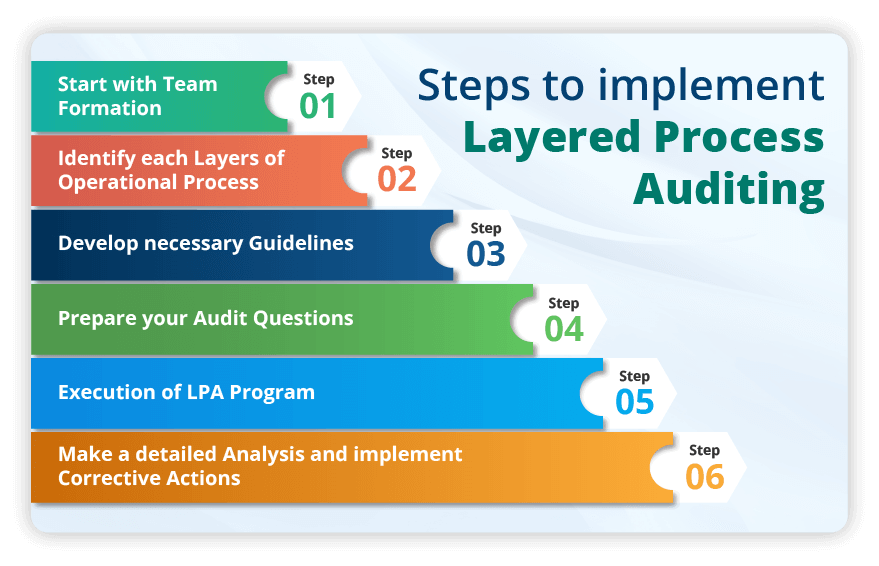Layered Process Audits (LPA) for Quality Management
Layered Process Audits enhances product quality, identify process inefficiencies, and ensure industrial standards in your organisation.
Try Process Audits for free Get a DemoContents
- What are Layered Process Audits (LPAs)?
- Where are Layered Process Audits used?
- Who is responsible for the Layered Process Audit?
- Why are Layered Process Audits important?
- How to do a Layered Process Audit?
- How often should Layered Process Audits be conducted?
- What tools and software are recommended for implementing Layered Process Audits?
- Is it necessary for companies with a well-functioning Quality Management System to implement Layered Process Audits?
- What are the solutions to avoid potential pitfalls while conducting Layered Process Audits?
- What are the benefits of implementing Layered Process Audits?
- How can you measure the effectiveness of the Layered Process Audit initiatives?
- How can a Layered Process Audit Checklist help you?
- What are Layered Process Audit Templates?
- ROI of Layered Process Audits
- Effective strategies for writing Layered Process Audit questions
- Comparing Gemba Audits and Layered Process Audits
- Example of Layered Process Auditing in Manufacturing Sector
What are Layered Process Audits (LPAs)?
Layered Process Audits (LPAs) are a systematic approach to quality management in the production process designed to enhance product and process conformance. The main purpose of implementing LPAs is to proactively identify and resolve potential issues, thus ensuring continuous improvement and preventing defects. This structured auditing methodology involves multiple layers of inspections performed at various organisational levels. Key components of a successful Layered Process Audit program include:
- Regular and consistent audits.
- Standardised audit checklists.
- Auditors from different departmental levels.
- A focus on real-time corrective actions.
By incorporating LPAs into the production process, companies can promote a culture of continuous improvement, enhance quality control, reduce defects, and ultimately enhance overall operational efficiency.
Where are Layered Process Audits used?
Layered Process Audits (LPAs) have widespread application across diverse industries, including Manufacturing, Automotive, HVAC, Aerospace,Plant hire, Pharma, Construction, Healthcare and many more. Organisations prioritising quality management and continuous improvement integrate LPAs into their production processes. LPAs are utilised in various stages, from assembly lines to quality checks. The versatility of LPAs makes them applicable in any industry where high-quality standards are maintained, and defects are reduced.
Who is responsible for the Layered Process Audit?
Layered Process Audits (LPAs) should be implemented by a diverse team of auditors spanning various organisational levels to ensure comprehensive coverage. The involvement of auditors at different layers ensures a thorough examination of processes, from the frontline to top-level management, promoting accountability and continuous improvement throughout the organisation. The different layers of audits in Layered Process Audits and the Auditors at different organisational levels include:
-
Layer 1 - Operators or Frontline Employees
- Conduct audits daily.
- Focus on routine tasks and immediate work areas.
-
Layer 2 - Supervisors or Team Leaders
- Conduct regular audits within their respective teams.
- Monitor process adherence and provide immediate feedback.
-
Layer 3 - Directors or Managers
- Perform periodic audits across departments quarterly or monthly.
- Oversee compliance with broader organisational processes and standards.
-
Layer 4 - Executives
- Conduct high-level audits with a strategic focus annually.
- Ensure alignment with organisational goals and long-term objectives.
Why are Layered Process Audits important?
Implementing Layered Process Audits (LPAs) is important for organisations that aim to enhance quality management and operational efficiency. LPAs provide a systematic approach to identifying and addressing potential issues in the production process, fostering a proactive quality culture. By involving auditors at various organisational levels, including operators, supervisors, directors, and executives, LPAs ensure comprehensive coverage and accountability. This structured auditing methodology helps prevent defects, streamline processes, and align operations with organisational goals. Implementing LPAs is essential to maintaining high standards, minimising risks, and achieving long-term market competitiveness.
How to do a Layered Process Audit?

A structured LPA framework thoroughly examines the production process and facilitates ongoing quality enhancement. To implement a successful Layered Process Audit (LPA), follow these six essential steps:
-
Step 1- Start with Team Formation
- Make a cross-functional team with representatives from various organisational levels.
- Ensure diverse expertise to assess different facets of the process comprehensively.
-
Step 2- Identify each Layers of Operational Process
- Identify distinct layers within the production process, including frontline operations.
- Define the scope and responsibilities of each operational layer's frontline operators, supervisors, managers, and executives to ensure comprehensive coverage.
-
Step 3- Develop necessary Guidelines
- Develop standardised audit guidelines outlining the specific criteria for each layer.
- Align guidelines with organisational objectives and industry standards for consistency.
-
Step 4- Prepare your audit Questions
- Create detailed and relevant audit questions based on the established guidelines.
- Ensure that your audit questions address key process components and potential areas of improvement.
-
Step 5- Execution of LPA Program
- Roll out the Layered Process Audit program according to the defined schedule.
- Assign specific audits to corresponding layers, promoting accountability and engagement.
-
Step 6- Make a Detailed Analysis and Implement Corrective actions
- Analyse audit findings to identify trends, patterns, and non-conformance areas.
- Implement corrective actions promptly, focusing on continuous improvement and preventive measures.
How often should Layered Process Audits be conducted?
The audit frequency for Layered Process Audits (LPAs) is critical to their effectiveness. LPAs are typically conducted regularly based on a predetermined LPA schedule, ensuring consistent monitoring of processes at various organisational levels. The frequency may vary based on factors such as industry standards, organisational goals, and the complexity of production processes. LPAs are commonly performed daily at the frontline operator level, with supervisors and team leaders conducting weekly or monthly audits. Directors and managers might perform audits monthly or quarterly, while executives may engage in high-level audits annually. Establishing a well-defined audit frequency is essential to maintaining a proactive and continuous improvement-oriented approach, allowing organisations to promptly address issues and drive sustained operational excellence.
What tools and software are recommended for implementing Layered Process Audits?
Specialised tools and software greatly simplify Layered Process Audits (LPAs), each offering unique advantages.
- T Cards : T cards, a visual management tool, are often employed for manual LPAs. These cards are placed at workstations to guide auditors through the audit process. The advantage lies in their simplicity and effectiveness in visually communicating audit requirements, making them particularly useful for frontline operators and supervisors.
- Kamishibai Board : Kamishibai Boards are visual control boards that facilitate the execution of daily audits. These boards use cards to represent different audits to ensure a systematic and routine approach to Layered Process Audits. They promote visual management, making identifying completed audits and outstanding tasks easy and fostering accountability and continuous improvement.
- Layered Process Audit Software: Layered Process Audit Software provides a centralised platform for planning, executing, and managing LPAs. These tools often come with pre-defined LPA templates, streamlining the audit creation process and ensuring consistency. Features may include automated scheduling, real-time data capture, and customisable reporting, enhancing efficiency and accuracy in audit management.
Book a Personalised demo to know how these tools can enhance your Process Audits!
Is it necessary for companies with a well-functioning Quality Management System to implement Layered Process Audits?
While a well-functioning Quality Management System (QMS) is essential for maintaining high standards, implementing Layered Process Audits (LPAs) remains valuable. LPAs provide an additional layer of proactive quality assurance by systematically assessing processes at various organisational levels. This ensures continuous improvement and early detection of potential issues, complementing the QMS. The combination of a robust QMS and LPAs enhances overall operational efficiency, reduces defects, and fosters a culture of quality throughout the organisation. Therefore, even companies with effective QMS can benefit from the strategic implementation of Layered Process Audits to further elevate their quality assurance practices.
What are the solutions to avoid potential pitfalls while conducting Layered Process Audits?
- Inconsistent Auditing Frequency: Establish a clear schedule and routine for audits, ensuring consistent and regular assessments at all organisational levels.
- Lack of Employee Engagement: Foster a culture of participation and ownership, encouraging employees to contribute actively to the Layered Process Audit program.
- Poorly Defined Audit Guidelines: Develop clear and standardised guidelines, providing auditors with specific criteria and expectations for a comprehensive assessment.
- Inadequate Training for Auditors: Training programs should be conducted to equip auditors with the necessary skills and knowledge for effective and consistent audits.
- Limited Corrective Action Implementation: Establish a robust system for analysing audit findings and promptly implementing corrective actions to address identified issues.
- Insufficient Communication of Results: Establish a transparent communication process to share audit results with relevant stakeholders, promoting awareness and accountability.
What are the benefits of implementing Layered Process Audits?
- Early Issue Detection: LPAs facilitate early identification of potential issues in the production process, allowing for timely corrective actions and preventing defects.
- Proactive Quality Culture: Implementing LPAs fosters a proactive quality culture within the organisation, encouraging employees at all levels to maintain high standards.
- Comprehensive Process Assessment: LPAs involve audits at various organisational layers, providing a comprehensive assessment of processes from frontline operators to executives, ensuring a holistic approach to quality management.
- Continuous Improvement: LPAs contribute to a cycle of continuous improvement by regularly assessing and addressing areas of non-conformance, leading to enhanced operational efficiency and product quality.
- Reduced Defects and Rework: The systematic approach of LPAs helps minimise defects and rework by proactively identifying and resolving issues, ultimately improving product conformance.
- Increased Operational Efficiency: Implementing LPAs leads to streamlined processes and increased operational efficiency, as potential bottlenecks and inefficiencies are addressed through systematic audits.
- Enhanced Accountability: LPAs promote accountability at all organisational levels, as each layer is actively involved in the audit process, taking ownership of their responsibilities and contributing to overall quality assurance.
- Improved Customer Satisfaction: By reducing defects and consistent product quality, LPAs improve customer satisfaction by delivering products that meet or exceed expectations.
- Alignment with Organisational Goals: LPAs ensure that operational processes align with organisational goals and standards, contributing to the overall success and competitiveness of the company in the market.
How can you measure the effectiveness of the Layered Process Audit initiatives?
Measuring the effectiveness of Layered Process Audit (LPA) initiatives involves tracking key metrics to evaluate their impact. Relevant LPA metrics include:
- Audit Completion Rate: Measure the percentage of scheduled audits that are successfully completed. A high completion rate indicates active engagement and commitment to the LPA program.
- Non-Conformance Rate: Assess the frequency of non-conformances identified during audits. A decreasing non-conformance rate signifies the effectiveness of LPAs in preventing and addressing issues.
- Corrective Action Closure Time: Track the time to implement corrective actions following audit findings. A shorter closure time reflects a prompt and efficient response to identified issues.
- Employee Participation Rate: Evaluate employee engagement in the LPA program. Higher participation rates demonstrate a widespread commitment to quality at all organisational levels.
- Trend Analysis: Analyse trends in audit findings over time. Identifying patterns allows organisations to address systemic issues and continuously improve processes.
- Customer Satisfaction: Link LPA initiatives to changes in customer satisfaction. A positive correlation suggests that LPAs deliver products that meet or exceed customer expectations.
How can a Layered Process Audit Checklist help you?
A Layered Process Audit checklist is a structured tool to systematically assess and improve various organisational processes. This checklist provides auditors with a comprehensive set of criteria and questions to evaluate specific tasks and areas within the production process. It ensures consistency and standardisation across audits, guiding auditors at different organisational levels, including operators, supervisors, managers, and executives. Organisations can proactively identify non-conformances, streamline processes, and foster a quality culture by utilising an LPA checklist. The checklist aids in documenting audit findings, facilitating data-driven decision-making and continuous improvement initiatives. Overall, the LPA checklist is an indispensable instrument for promoting accountability, adherence to standards, and overall operational excellence.
What are Layered Process Audit Templates?
A Layered Process Audit (LPA) template is a foundational framework to streamline and standardise the audit process. This template provides a structured format with predefined sections, criteria, and questions tailored to the organisation's needs. The LPA template enhances consistent data collection, facilitating process performance analysis. It also facilitates the documentation of audit results, aiding in the analysis of non-conformances and implementing corrective actions. The LPA template is a valuable tool for enhancing the overall effectiveness of the audit program, promoting accountability, and driving continuous improvement in quality management processes.
ROI of Layered Process Audits
The Return on Investment (ROI) of Layered Process Audits (LPAs) manifests through improved operational efficiency, reduced defects, and enhanced product quality. LPAs contribute to early issue detection, minimising the risk of costly defects and recalls. The systematic approach of LPAs fosters a proactive quality culture, aligning processes with organisational goals and industry standards. By preventing defects and streamlining operations, LPAs result in long-term cost savings, increased customer satisfaction, and a sustainable foundation for continuous improvement. The investment in LPAs yields a substantial ROI as organisations experience reduced rework, improved compliance, and heightened overall competitiveness in the market.
Effective strategies for writing Layered Process Audit questions
- Align with Objectives: Ensure questions directly correlate with organisational goals and Key Performance Indicators.
- Specificity is Key: Formulate questions to address specific aspects of the process, avoiding ambiguity for precise evaluations.
- Incorporate Regulatory Compliance: Include questions that assess adherence to industry regulations and standards relevant to the organisation.
- Check Process Complexity: Craft questions that consider the complexities of the process being audited, capturing its full complexity.
- Encourage Employee Insight: Design questions that prompt frontline employees to share their insights and observations during the audit.
- Prioritise Critical Tasks : Focus on questions that target critical tasks and stages within the process to identify potential vulnerabilities.
- Use Open-ended Questions: Include open-ended questions to encourage detailed responses and uncover nuanced issues.
- Link to Customer Requirements: Ensure questions are aligned with customer expectations, linking process performance to customer satisfaction.
Comparing Gemba Audits and Layered Process Audits
| Aspect | Gemba Audits | Layered Process Audits (LPAs) |
|---|---|---|
| Focus | On-site observation of actual work processes and practices | Systematic assessment of processes at various organisational levels |
| Scope | Generally broader, covering overall operations | Specific, targeting individual tasks and areas within processes |
| Initiation | Typically initiated by management or process owners | Can be initiated at various levels, involving frontline employees |
| Employee Involvement | Encourages active participation and input from employees | Involves employees at different organisational layers as auditors |
| Tools and Techniques | Relies on direct observation, discussions, and visual aids | Utilises LPA checklists, standardised guidelines, and structured questions |
| Decision-Making Influence | Directly informs immediate decisions and process improvements | Influences decisions at various organisational levels, contributing to continuous improvement |
| Documentation | May involve informal notes and observations | Typically involves detailed documentation of audit findings and corrective actions |
| Risk Identification | Identifies risks through direct observation and real-time analysis | Systematically identifies risks through layered assessments at different levels |
| Cultural Impact | Emphasises a culture of continuous improvement and employee engagement | Fosters a proactive quality culture, promoting accountability and adherence to standards |
Example of Layered Process Auditing in Manufacturing Sector
Let's consider a specific example of Layered Process Audits in the assembly line of an automotive manufacturing plant.
- Situation: In the assembly line of an automotive plant, the organisation implements LPAs to enhance the quality of the final product. The production process involves multiple stages, from chassis assembly to final vehicle inspection.
- Layer 1 - Operators (Frontline Employees): Operators conduct daily audits focusing on their specific tasks, such as ensuring proper torque specifications for bolts, accurately placing components, and verifying the functionality of individual vehicle systems.
- Layer 2 - Supervisors (Team Leaders): Supervisors perform regular audits within their teams, checking for adherence to standardised work procedures, confirming that operators follow safety protocols, and verifying that any reported issues are addressed promptly.
- Layer 3 - Directors (Managers): Directors conduct periodic audits across different sections of the assembly line. They assess the overall efficiency of the production process, review compliance with quality standards, and evaluate the effectiveness of corrective actions from previous audits.
- Layer 4 - Executives: Executives participate in strategic audits, focusing on aligning manufacturing processes with broader organisational goals. They may assess the implementation of advanced technologies, sustainability initiatives, and overall competitiveness within the automotive market.
Upgrade your Process Audits with Kamishibai TCard Boards
Take your first step toward smarter, more effective layered process audits. Start enhancing process compliance and performance today!


